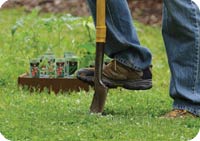Building your garden
Burpee Edible Gardening Team Members

Enough with the planning and dreaming – it’s time to plant your garden! While everyone’s garden can be a different shape and size, when it comes to digging into the ground, there are a few guidelines you can follow…
Layout
With a tape measure, four thin stakes and a piece of string you can outline the general shape of your garden. Any size is fine, but a good start is 6 ft. by 8 ft. or 10 ft. by 10 ft. Once you have your size set, you can also use white spray paint to mark where your string lines are for digging.
Digging
Wit a sharp, square-edged shovel, cut along your string or painted lines, going down 4 to 5 inches deep. Moist ground will be easier to dig than dry, so you may want to dig just after a rain – or water your garden location the night before.
Remove Sod
Use a shovel to cut the turf into strips, and then cut the strips into easy-to-handle squares (sort of like removing indoor carpeting!). The sod comes up when you force your shovel under each square and lift. You can discard the sod or use it to fill in bare spots on your lawn.
Loosen The Soil
Once the sod is removed, your shovel can loosen the soil to a depth of 8 to 10 inches. If you have a rototiller, that’s even better! You can rent or borrow one; it makes this job a breeze. But a shovel will give you lots of exercise, too. As the soil is loosened, this is the time to decide if you need to amend it with compost or other organic matter (most yard soils can use a bit of help).
Level It Out
Level the now-loose soil with a hard rake, being careful not to pack it down with your feet. Pick out any rocks, roots and weeds. A good tip: Create a 1 ft. wide walkway down the center to allow easy access to your wider garden plots. You’ll be able to maintain your garden easier as the season wears on.
Fertilize
“Top-dress” your garden soil with granual fertilizer. Spread a few handfuls of fertilizer over the areas you’re about to plant, then use your rake to work it into the soil.
Planting Time
Hey look! Your garden is ready for plants! So now’s the time to decide what goes where. Tall plants and staked plants should be on the north side, so they won’t shade shorter plants. Use the spacing guidelines on the tag or seed pack to determine how far apart they should go.
Water
Give your new garden a gentle but thorough watering as soon as possible after planting, so your young plants won’t wilt.
Staking
Within a few days to a few weeks you can begin staking those plants that will need a little more support, such as tomatoes and pole beans, or other climbers.
It’s as easy (and as exhilarating) as that! All of this information and more can be found in the new Garden Fresh gardening guide from Burpee Home Gardens. Have you signed up to receive your free copy yet? Click here to learn more and fill out the form.
If you have any questions, ask us below! Or if you have tips to share for digging in and getting started, we welcome those, too.